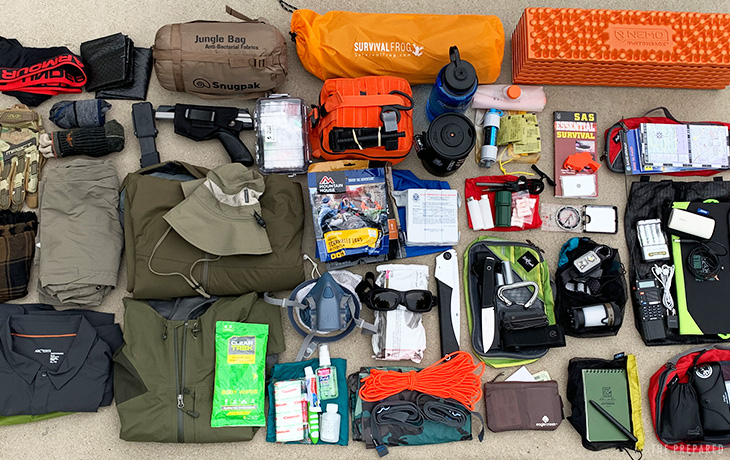Southern Colorado Chapter
This group is open to all AmCon members but geographically focuses on Southern Colorado. Our mission is to bring like-minded patriots together and create a network of reliable allies helping each other prepare for whatever comes next. We are Americans from different backgrounds working toward the common goal of better preparing ourselves as individuals and as a community.
Prepare. Mobilize. Defend.
Tips and common BOB mistakes from The Prepared:
Don’t carry too much weight (details in next section).
Don’t design your bags based on specific timelines such as three days or two weeks — use a priority cascade instead and ignore the BOB vs. INCH arguments.
Don’t pack a bunch of extras. The point is to survive — not to battle zombie hordes. That essentially boils down to staying hydrated, fed, warm, dry, and uninjured. Everything else supports those goals or is a bonus.
Don’t assume your predetermined path and “bug out location” will work the way you hope. You are not prepared if you can’t handle unpredictable disruptions to your plans.
Be thoughtful about the environment around you and what risks are likely — but don’t get tunnel vision on specific scenarios like earthquakes or hurricanes. Spend more time thinking about things like terrain, whether or not there will be water (or too much water), temperature variances, urban vs. rural, if everyone around you is likely (or not) to be armed, and so on.
You don’t want to be at either extreme in the “carry a bunch of fish vs. teach a man to fish” tradeoff. Don’t simply carry 72 hours worth of consumables, and don’t skip consumables assuming you’ll hunt and craft your way through (unless you’ve already proven that you comfortably can in your area).
Premade kits are not looked at favorably by experts because almost every company tries to get under a $50-$200 price point by cutting corners, ie. including cheap gear you cannot depend on, having the wrong mix of gear to begin with, or requiring you to replace/add so much stuff that it defeats the purpose.
A good kit, even a basic one, is not going to be cheaper than $150-200. You spend more than that each month on insurance, so don’t skimp on this critical prep.
If you’re on a limited budget, don’t go cheaper than any of the “budget picks” we recommend in our reviews — it’s not worth buying a prep item if it will fail when you need it, and almost all of the uber-budget items found online are crap. Generally speaking, the cheaper the products, the heavier they will be. A budget Level 3 bag, for example, will likely weigh multiple pounds more than average. Whether you use the same budget for a great Level 1 bag or a middle-of-the-road Level 2 bag is up to you, for example.
You can’t assume your party/family will always be together, so don’t spread critical gear across bags. For example, it’s a bad idea to have water gear in one bag and food in another. Every person over 10 years old should have their own essentials in case they get separated.
Children under 10 can have their own bags, but you build theirs more for their comfort and your redundancy. In other words, build a child’s bag so that if they get separated they at least have some basic stuff/info to aid whatever adult finds them, and so you can raid their bag if you lose something critical like your water filter. But make sure it’s no big deal if they lose the bag altogether. In a bag that’s small enough to be appropriate for their age, you can usually fit in a few essentials such as a full set of clothes, special medicines, and documents/photos about their family and home, while adding more kid-friendly items like a stuffed animal, book, and sweets.
Don’t just throw everything into one pile in your bag. Not only does compartmentalizing your gear help you find it in a hurry and create better load distribution while carrying, the individual containers themselves are a great stem cell if you need to improvise something in the field.
There are only two items on this list that don’t need to be kept in your bag at all times: shoes and cell phones — and that’s only because it’s impractical to do so + it’s safe to assume 99% of people will have them on hand or nearby when it’s time to bug out.
Don’t double dip, mix gear with your camping/hiking supplies, or take other shortcuts that might stop you from being able to grab and go without thinking. Part of the whole purpose of a bug out bag is knowing that it’s ready at all times.
https://theprepared.com/bug-out-bags/guides/bug-out-bag-list/
Thanks for your interest in the South Colorado Chapter of American Contingency!
For the security of all our members, we do require all members be vetted by AmCon HQ and to have a Proton Mail account. If you're unsure whether you've been vetted or are in the process, feel free to reach out to us.
Please contact us at:
[email protected]
if you're interested in joining our group or have any questions.
Prepare. Mobilize. Defend.
1. Not Planning
2. Being Unrealistic
3. Not Expecting the Unexpected
4. Growing the Wrong Food
5. Not Developing the Right Skills
Do you agree? Share the biggest mistake you made as a new homesteader/prepper below!
https://15acrehomestead.com/mistakes-homesteaders-make/















